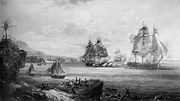
Raking fire
Encyclopedia

Naval warfare
Naval warfare is combat in and on seas, oceans, or any other major bodies of water such as large lakes and wide rivers.-History:Mankind has fought battles on the sea for more than 3,000 years. Land warfare would seem, initially, to be irrelevant and entirely removed from warfare on the open ocean,...
, raking fire is fire directed parallel to the long axis of an enemy ship
Ship
Since the end of the age of sail a ship has been any large buoyant marine vessel. Ships are generally distinguished from boats based on size and cargo or passenger capacity. Ships are used on lakes, seas, and rivers for a variety of activities, such as the transport of people or goods, fishing,...
. Although each shot is directed against a smaller target profile than by shooting broadside
Broadside
A broadside is the side of a ship; the battery of cannon on one side of a warship; or their simultaneous fire in naval warfare.-Age of Sail:...
and thus more likely to miss the target ship to one side or the other, an individual cannon
Cannon
A cannon is any piece of artillery that uses gunpowder or other usually explosive-based propellents to launch a projectile. Cannon vary in caliber, range, mobility, rate of fire, angle of fire, and firepower; different forms of cannon combine and balance these attributes in varying degrees,...
shot that hits will pass through more of the ship, thereby increasing damage to the hull, sail
Sail
A sail is any type of surface intended to move a vessel, vehicle or rotor by being placed in a wind—in essence a propulsion wing. Sails are used in sailing.-History of sails:...
s, and crew
Crew
A crew is a body or a class of people who work at a common activity, generally in a structured or hierarchical organization. A location in which a crew works is called a crewyard or a workyard...
. A stern
Stern
The stern is the rear or aft-most part of a ship or boat, technically defined as the area built up over the sternpost, extending upwards from the counter rail to the taffrail. The stern lies opposite of the bow, the foremost part of a ship. Originally, the term only referred to the aft port section...
rake is more damaging than a bow
Bow (ship)
The bow is a nautical term that refers to the forward part of the hull of a ship or boat, the point that is most forward when the vessel is underway. Both of the adjectives fore and forward mean towards the bow...
rake because the shots are not deflected by the curved (and strengthened) bow.
The effectiveness of this tactic was demonstrated at the Battle of Trafalgar
Battle of Trafalgar
The Battle of Trafalgar was a sea battle fought between the British Royal Navy and the combined fleets of the French Navy and Spanish Navy, during the War of the Third Coalition of the Napoleonic Wars ....
. Admiral Nelson
Horatio Nelson, 1st Viscount Nelson
Horatio Nelson, 1st Viscount Nelson, 1st Duke of Bronté, KB was a flag officer famous for his service in the Royal Navy, particularly during the Napoleonic Wars. He was noted for his inspirational leadership and superb grasp of strategy and unconventional tactics, which resulted in a number of...
's HMS Victory
HMS Victory
HMS Victory is a 104-gun first-rate ship of the line of the Royal Navy, laid down in 1759 and launched in 1765. She is most famous as Lord Nelson's flagship at the Battle of Trafalgar in 1805....
, leading the weather column of the British fleet, broke the French line just astern of the French flagship Bucentaure
French ship Bucentaure (1804)
Bucentaure was a 80-gun ship of the line of the French Navy, lead ship of her class. She was the flagship of Vice-Admiral Latouche Tréville, who died on board on 18 August 1804....
, and just ahead of Redoutable
French ship Redoutable (1791)
The Redoutable was a Téméraire class 74-gun ship of the line of the French Navy. She is known for her duel with HMS Victory during the Battle of Trafalgar and for killing Vice Admiral Horatio Nelson during the action.- Early career :...
. Victory raked the Bucentaure's less protected stern killing 197 and wounding a further 85, including the Bucentaure's captain, Magendie
Jean-Jacques Magendie
Jean-Jacques Magendie was a French Navy officer. He famously captained the flagship Bucentaure at the Battle of Trafalgar.- Early career :...
. Admiral Villeneuve
Pierre-Charles Villeneuve
Pierre-Charles-Jean-Baptiste-Silvestre de Villeneuve was a French naval officer during the Napoleonic Wars. He was in command of the French and Spanish fleets defeated by Nelson at the Battle of Trafalgar....
was lucky to survive, and although he was not captured for three hours, the raking put Bucentaure out of the fight.

